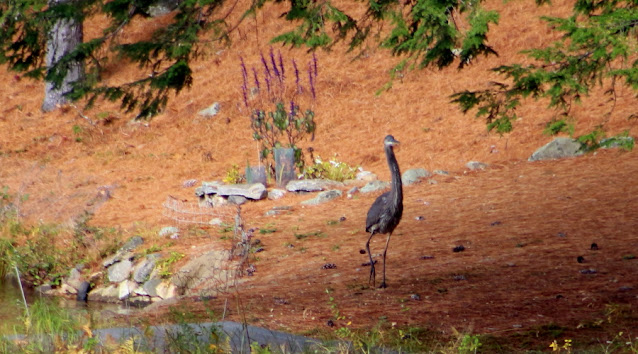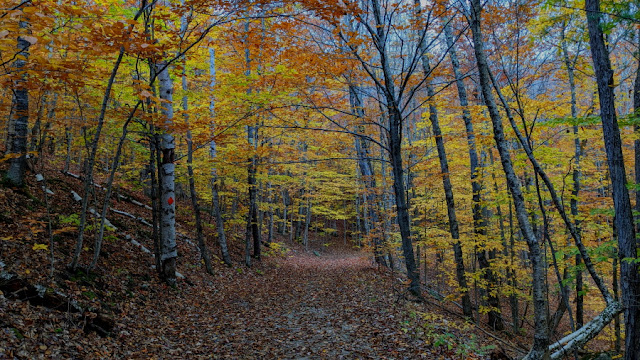Late October is treating us well this year. I spent one of those fabulous warm days this week in the Ossipee mountains on a trek up Mt. Roberts. As expected on a warm humid day, the distant views were hazy, but other sights were brilliant, and the color of the day was red with the mountain ash at the summit of Roberts stealing the show.
 |
| The White Mountains languish in the haze behind a red ribbon of mountain ash. |
American Mountain Ash (Sorbus americana) is a northern species, though it does grow as far south as Georgia at high elevation in the Appalachian Mountains. I remember first seeing them on the Appalachian Trail in North Carolina. Their abundant bright red berries last well into winter, providing high calorie food to animals that inhabit the alpine zone such as grouse; moose browse on their winter twigs and sweet bark.
I've seen both grouse and moose on Mount Roberts and the High Ridge Trail leading over to Mt Shaw. Mt. Roberts is a moderate but highly rewarding 5.5 mile hike with great views of mountains and lakes from the many open ledges. You can pick up a
trail map describing the many hiking trails from the
Lakes Region Conservation Trust which stewards over 5000 acres of land in the Ossipee Mountains.
 |
| Views along the Mt. Roberts Trail are nice even on a hazy October day. |
On the hike up, well before I reached the summit and the mountain ash, another red flash had already caught my eye.
 |
| Three-toothed Cinquefoil (Sibbaldiopsis tridentata) |
Three-toothed cinquefoil is an evergreen plant, keeping its leaves throughout the winter; the red leaves are last year's growth. I don't know what happens in the third year, but there are dead, gray leaves on the ground so my guess is they are shed after two years. It's a resilient alpine plant that thrives in the harsh environment by rooting itself in the tiniest cracks in the granite, and growing low to the ground under the winter snow. On the bare ledges leading to the summit there was an abundance of these hardy plants.
 |
| Finding life in a crack in the granite. |
At lower elevations the colors slanted higher in the color spectrum with yellow and burnt orange predominating.
 |
| Beech trees along the Settlement Trail. |
The beech stands formed a tunnel through which the trail passes.
Back down at lake-level there's still some red to see: a few late maples and the deep red of huckleberry bushes along the shore.
 |
| Huckleberry might hang on to their leaves well into November. |
Things were very quiet on my long, lazy paddle around the lake, trying to make the late summer moment last. No more kip-kip call of the osprey, no loons pestering their parents (I saw only one lone loon - no sign of LuLu or Checkers), no turtles sunning themselves on a log on that sunny, 70 degree day.
 |
| Looking for excuses to dawdle on the lake. |
Yes, things are starting to wind down as the days become shorter and the water cooler, though some locals are still hanging around.
 |
| Having just landed, a great blue heron walks to one of its favorite fishing spots. |
Did you see the full October moon on Friday night? I caught it as it was setting on Saturday morning, with Venus watching over from above.
It was a near-monochromatic scene, but just a few minutes later came the real show, in full technicolor, courtesy of Neil Crimins.
 |
| Thanks for sharing Neil! |
Can we please have a few more days like this?














Amazing pictures Scott. Yes, I’d like some more days like this.
ReplyDeleteSpectacular photos!
ReplyDelete